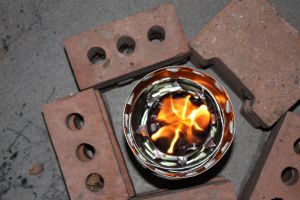The Saint Isidore Society has been building small cook or camp stoves out of salvaged cans.
(Pictures of our TLUD stove No. 2)
Before I get into the results of our stove experiments, I will give a brief description of the principles behind each kind of stove.
Rocket stoves utilize abrupt right angle bends, an internal insulated chimney, and certain critical proportions to create an extremely efficient, nearly smoke-less burn. They can keep a few small sticks burning for a long time, unlike an open fire.
TLUD biochar producing stoves heat biomass in an oxygen poor environment, producing wood gas, the volatile components of organic matter. This gas is then mixed with preheated air, which produces a clean, efficient flame. They can burn agricultural waste, pine needles, etc., unlike a rocket stove.
Our rocket stove 1 burned cleanly, though it did produce a little smoke, especially when starting off. It boiled two cups of water in a covered pot in ten minutes. (For comparison, an electric stove with a glass top boils water in about six minutes.) We also toasted some marshmallows.
Our rocket stove 2 burned faster then number 1, and also produced some smoke. It boiled two cups of water in five minutes. However, we used two cotton balls dipped in alcohol to start this, and there was probably still some alcohol burning when we put the pan on. This may have skewed results. The first stove’s cotton balls had burned out a long time before we put the pot on, so those results are reliable.
The TLUD stove burned a soup can full of pine needles for about ten minutes, completely charring them all. It produced a hot, clean flame, but we did not try to boil water. The alcohol cotton balls we used to start it burned for ten minutes before the needles started to char. (In a TLUD the starter sits on top of the fuel and the charring moves down through it.) The small amount of pine needle biochar produced was not worth doing anything with.
Next we will retry our experiment on rocket stove 2 without the alcohol effect, and outfit both rocket stoves with shields to direct more heat to the pots. We will be building a larger and more robust biochar stove fuelled with wood instead of pine needles. We will probably be experimenting with larger rocket stoves and with a haybox cooker used in conjunction with rocket or TLUD stoves.



